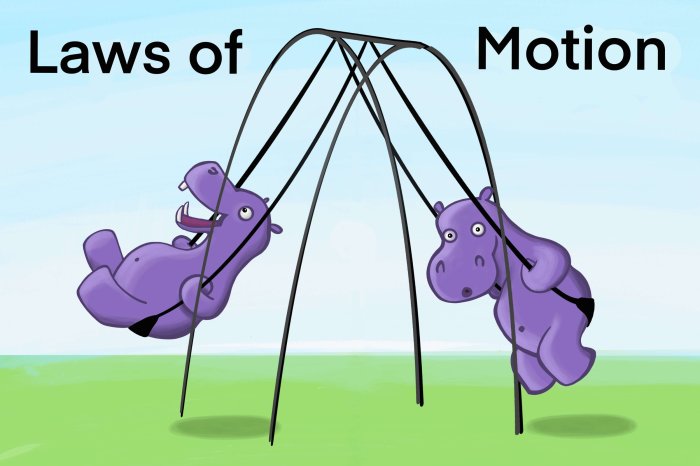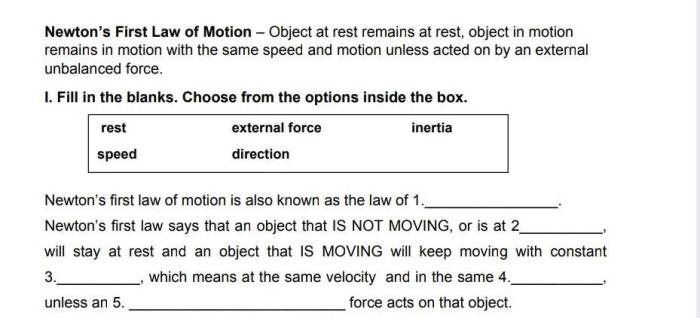
What was Newton’s first law of motion? This fundamental principle, known as the Law of Inertia, lies at the heart of our understanding of how objects move and interact. Sir Isaac Newton, a renowned physicist, revolutionized our comprehension of motion with his three laws, each unveiling a crucial aspect of how objects behave in the physical world.
Newton’s First Law of Motion states that an object at rest will remain at rest, and an object in motion will continue in motion with the same speed and in the same direction unless acted upon by an unbalanced force. This concept of inertia is the inherent tendency of an object to resist changes in its state of motion.
Introduction to Newton’s Laws of Motion

Sir Isaac Newton, an English physicist and mathematician, revolutionized our understanding of motion with his three laws of motion, published in his groundbreaking work “Philosophiæ Naturalis Principia Mathematica” in 1687. These laws form the foundation of classical mechanics, a branch of physics that describes the motion of objects under the influence of forces.
Newton’s laws of motion are essential for comprehending the physical world around us. They provide a framework for understanding the motion of everything from celestial bodies to everyday objects. These laws are used in various fields, including engineering, aerospace, and even sports.
Historical Context of Newton’s Laws
Newton’s laws were not formulated in a vacuum. They emerged from a rich history of scientific inquiry that spanned centuries. Before Newton, philosophers and scientists had attempted to explain the nature of motion. For example, Aristotle, a Greek philosopher, believed that objects moved naturally towards their “natural place.” This idea was prevalent for centuries.
However, in the 16th century, Nicolaus Copernicus proposed the heliocentric model of the solar system, which challenged the long-held belief that the Earth was the center of the universe. Galileo Galilei, an Italian astronomer, conducted experiments that provided evidence for Copernicus’s theory. Galileo’s work laid the foundation for Newton’s laws of motion.
Newton built upon the work of his predecessors, incorporating their observations and insights into his own groundbreaking theories. He developed a mathematical framework that could accurately predict the motion of objects under the influence of forces.
Significance of Newton’s Laws
Newton’s laws of motion have profound implications for understanding the physical world. They explain why objects fall to the ground, why planets orbit the sun, and why objects at rest tend to stay at rest.
- Inertia: Newton’s first law states that an object at rest will remain at rest, and an object in motion will continue in motion with the same speed and in the same direction unless acted upon by an unbalanced force. This fundamental principle explains why a ball rolling on a flat surface eventually comes to a stop due to friction. It also explains why a car continues to move forward even after the driver releases the gas pedal, unless a force, such as friction or braking, acts upon it.
- Acceleration: Newton’s second law states that the acceleration of an object is directly proportional to the net force acting on it and inversely proportional to its mass. This law explains how forces cause changes in motion. For example, a larger force will cause a greater acceleration, and a more massive object will accelerate less for the same force. This law also explains why a heavier object requires more force to move the same distance as a lighter object.
- Action-Reaction: Newton’s third law states that for every action, there is an equal and opposite reaction. This means that whenever one object exerts a force on another object, the second object exerts an equal and opposite force on the first object. This law explains why we can walk on the ground, why rockets launch into space, and why a swimmer pushes against the water to propel themselves forward.
Newton’s First Law of Motion
Newton’s First Law of Motion, also known as the Law of Inertia, is a fundamental principle in physics that describes the behavior of objects in motion or at rest. It states that an object at rest will remain at rest, and an object in motion will stay in motion at a constant velocity, unless acted upon by an external force. This means that objects tend to resist changes in their state of motion.
Examples of Objects at Rest and in Motion
Inertia is a property of all matter that describes its resistance to changes in motion. It is the tendency of an object to stay at rest or to continue moving at a constant velocity. Here are some real-world examples of objects at rest and in motion that illustrate the concept of inertia:
- Objects at Rest:
- A book lying on a table will remain at rest unless someone picks it up or pushes it. The book’s inertia keeps it from moving.
- A car parked on a flat surface will stay parked unless someone starts the engine and accelerates it. The car’s inertia keeps it from moving.
- Objects in Motion:
- A ball rolling on a smooth surface will continue to roll at a constant velocity until it encounters friction or another force that slows it down. The ball’s inertia keeps it moving.
- A hockey puck sliding on ice will continue to slide at a constant velocity until it encounters friction or another force that stops it. The puck’s inertia keeps it moving.
Inertia in Everyday Objects and Phenomena
Inertia plays a significant role in various everyday objects and phenomena. Here are some examples:
- Riding a Bicycle: When you start pedaling a bicycle, you need to overcome the inertia of the bicycle and yourself. Once you are moving, you can coast because the inertia of the bicycle keeps it moving forward. When you stop pedaling, you need to apply the brakes to overcome the inertia of the bicycle and bring it to a stop.
- Headrests in Cars: Headrests are designed to prevent whiplash injuries during a sudden stop. When a car brakes abruptly, the inertia of your body tends to continue moving forward. The headrest helps to prevent your head from snapping back and causing injury.
- Seat Belts: Seat belts are also designed to protect you in a car crash. When a car collides with another object, the inertia of your body tends to continue moving forward. The seat belt helps to keep you in your seat and prevent you from being thrown forward and injured.
Understanding Inertia
Inertia is a fundamental concept in physics that describes an object’s resistance to changes in its state of motion. In simpler terms, it’s the tendency of an object to stay at rest if it’s at rest, or to keep moving at a constant speed and direction if it’s already in motion.
The Relationship Between Mass and Inertia
The amount of inertia an object possesses is directly proportional to its mass. This means that the more massive an object is, the harder it is to start it moving or to stop it once it’s in motion. Think of it this way: it takes more effort to push a heavy box than a lightweight one.
Demonstrating Inertia with a Simple Experiment
To illustrate the concept of inertia, you can conduct a simple experiment. You will need:
* A smooth, flat surface
* A coin
* A piece of cardboard or paper
Procedure:
1. Place the coin on the cardboard.
2. Hold the cardboard firmly and quickly pull it out from under the coin.
Observation:
You will observe that the coin remains in place while the cardboard moves away from under it. This is because the coin’s inertia resists the change in motion, causing it to stay at rest even though the supporting surface is removed.
Inertia vs. Momentum
While inertia and momentum are closely related concepts, they are not the same.
* Inertia is the tendency of an object to resist changes in its state of motion. It is a property of an object’s mass.
* Momentum is a measure of an object’s motion, taking into account both its mass and its velocity. It is a vector quantity, meaning it has both magnitude and direction.
The formula for momentum is: Momentum (p) = mass (m) x velocity (v)
In summary, inertia is a property that relates to an object’s resistance to changes in motion, while momentum is a measure of an object’s motion. Both concepts are important in understanding the motion of objects in the universe.
Applications of Newton’s First Law

Newton’s First Law of Motion, also known as the Law of Inertia, finds numerous applications in various fields, particularly in engineering and technology. It governs the behavior of objects at rest or in motion and provides insights into how forces affect their movement.
Engineering and Technology Applications
Engineers and technologists extensively apply Newton’s First Law to design and develop various systems and structures. The principle of inertia helps predict how objects will respond to forces, ensuring stability and safety in various applications.
- Building Structures: Architects and structural engineers utilize the principle of inertia to design buildings that can withstand forces such as wind, earthquakes, and gravity. By understanding how objects resist changes in motion, they can incorporate structural elements that distribute and absorb these forces effectively. For instance, skyscrapers are designed with heavy, reinforced concrete foundations to provide stability and resist the inertia of the building during strong winds or seismic events.
- Vehicle Design: The design of vehicles, from cars to airplanes, heavily relies on Newton’s First Law. Engineers consider the inertia of the vehicle and its occupants during braking, acceleration, and turning. They incorporate features like crumple zones in cars to absorb the impact of a collision, minimizing the inertia’s effect on passengers. The design of aircraft wings and control surfaces also takes into account the inertia of air molecules, enabling controlled flight.
- Roller Coasters: Roller coaster design utilizes the principle of inertia to create thrilling rides. The roller coaster cars accelerate and decelerate as they navigate loops and drops, exploiting the inertia of the passengers to provide exhilarating experiences. The track’s design and the placement of hills and dips are meticulously calculated to ensure that the coaster cars maintain their momentum and avoid sudden stops or jolts, providing a smooth and exciting ride.
- Spacecraft Propulsion: Newton’s First Law is fundamental to spacecraft propulsion. In the vacuum of space, there is no air resistance, and spacecraft rely on inertia to maintain their motion. Rocket engines generate thrust by expelling mass, which creates a force that propels the spacecraft forward. Once the spacecraft is in motion, it continues moving in a straight line at a constant speed unless acted upon by an external force.
Seatbelts and Airbags
Seatbelts and airbags are crucial safety features in vehicles that directly utilize the principle of inertia to protect passengers during accidents.
- Seatbelts: Seatbelts work by restraining passengers’ bodies during sudden stops or collisions. When a vehicle abruptly decelerates, the passengers’ bodies, due to inertia, tend to continue moving forward at the original speed. Seatbelts prevent the passengers from being thrown forward, reducing the risk of severe injuries.
- Airbags: Airbags are designed to inflate rapidly during a collision, providing a cushion for the passengers. When a vehicle crashes, the passengers’ bodies, due to inertia, move forward. The airbag inflates, slowing down the passengers’ forward momentum, minimizing the impact force and reducing the risk of serious injuries.
Influence on Vehicle Design
Inertia plays a crucial role in the design of vehicles, influencing their handling, performance, and safety.
- Handling and Stability: The distribution of mass in a vehicle influences its handling and stability. A lower center of gravity minimizes the vehicle’s tendency to tip over when turning, while a balanced weight distribution improves stability and reduces the effects of inertia during sudden maneuvers.
- Acceleration and Braking: Inertia affects the acceleration and braking performance of vehicles. A heavier vehicle requires more force to accelerate and decelerate due to its greater inertia. Engineers optimize engine power and braking systems to overcome the inertia of the vehicle and its occupants, ensuring efficient acceleration and safe braking.
- Safety Features: Safety features like crumple zones and side impact beams are designed to absorb the impact of collisions and minimize the effect of inertia on passengers. These features allow the vehicle to deform in a controlled manner, slowing down the passengers’ forward momentum and reducing the severity of injuries.
Newton’s First Law and Everyday Life

Newton’s First Law of Motion, also known as the Law of Inertia, is not just a theoretical concept; it’s a fundamental principle that governs our everyday experiences. We encounter its effects in various ways, shaping how we move, interact with our surroundings, and even perceive the world around us.
Inertia and Our Movement
Inertia is the tendency of an object to resist changes in its state of motion. This means that an object at rest wants to stay at rest, and an object in motion wants to stay in motion at a constant velocity. Our bodies, being objects, are subject to inertia as well.
Here are some examples of how inertia affects our movement:
- When a car suddenly accelerates, we feel pushed back against our seats. This is because our bodies are trying to maintain their state of rest, while the car is accelerating forward.
- Similarly, when a car suddenly brakes, we feel a forward lurch. Our bodies are trying to maintain their state of motion, while the car is decelerating.
- When we jump, we push off the ground to propel ourselves upward. This is because our bodies are initially at rest, and we need to overcome our inertia to start moving.
- When we walk or run, our feet push against the ground, and the ground pushes back on our feet, allowing us to move forward. This is another example of overcoming inertia.
Inertia and Balance
Inertia plays a crucial role in maintaining our balance. When we stand still, our bodies are in equilibrium, with our weight balanced by the forces acting upon us. However, if we move suddenly, our inertia can disrupt this balance.
- When we walk or run, we constantly adjust our balance to compensate for the shifting of our weight. Our brain uses information from our eyes, ears, and muscles to predict and correct for changes in our balance.
- When we stand on a moving bus or train, our bodies tend to lean in the opposite direction of the movement. This is because our bodies are trying to maintain their state of rest relative to the ground, while the bus or train is moving.
- When we are on a swing, our bodies experience inertia as we swing back and forth. This inertia helps us to maintain our momentum and keeps us swinging.
Inertia and Perception of Motion and Forces, What was newton’s first law of motion
Our perception of motion and forces is also influenced by inertia. We often misinterpret or fail to fully perceive the forces acting upon us due to the effects of inertia.
- When we are in a car that is accelerating, we may feel as though we are being pushed back into our seats. However, this is actually due to inertia. Our bodies are trying to maintain their state of rest, while the car is accelerating forward. The feeling of being pushed back is a result of our bodies resisting this change in motion.
- Similarly, when we are in a car that is braking, we may feel as though we are being pulled forward. Again, this is due to inertia. Our bodies are trying to maintain their state of motion, while the car is decelerating. The feeling of being pulled forward is a result of our bodies resisting this change in motion.
- When we are on a roller coaster, we experience a variety of forces, including gravity, centrifugal force, and inertia. These forces can combine to create a feeling of weightlessness or even a feeling of being pushed into our seats. This is because our bodies are constantly adjusting to the changing forces acting upon them.
Final Wrap-Up: What Was Newton’s First Law Of Motion
Newton’s First Law of Motion, the Law of Inertia, is a cornerstone of physics, providing a foundational understanding of how objects behave in the universe. From the simple act of walking to the complex workings of spacecraft, this law governs the movement of everything around us. Understanding inertia is essential for comprehending a wide range of phenomena, from the design of vehicles to the behavior of celestial bodies. By grasping this fundamental principle, we gain a deeper appreciation for the intricate workings of the physical world.
Frequently Asked Questions
What is the difference between inertia and momentum?
Inertia is the tendency of an object to resist changes in its state of motion. Momentum, on the other hand, is a measure of an object’s mass in motion. Inertia is a property of an object, while momentum is a quantity that depends on both mass and velocity.
How does inertia affect the design of vehicles?
Inertia plays a crucial role in vehicle design. Seatbelts and airbags are designed to mitigate the effects of inertia during collisions, protecting passengers from injury. Vehicle manufacturers also consider inertia when designing suspension systems, which help to absorb shocks and provide a smooth ride.
Can inertia be overcome?
Yes, inertia can be overcome by applying an unbalanced force. For example, a stationary object can be set in motion by pushing or pulling it, and a moving object can be stopped by applying a force in the opposite direction of its motion.




